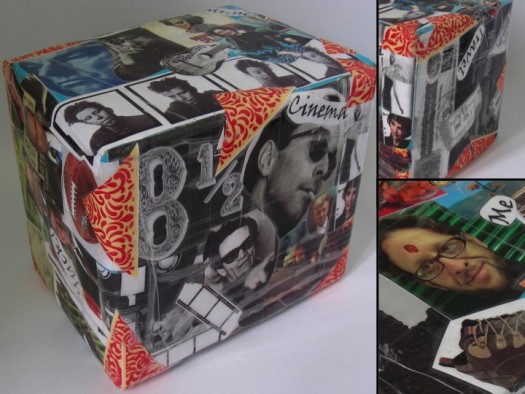
The All About Me Collage Cube
Michael Aliprandini, Italy
Michael Aliprandini is currently a teacher-trainer for the Associazione Culturale Linguistica Educational in Italy. His professional interests include humanistic education, CLIL, action research, and educational coaching. E-mail: michael@acle.it
Menu
Quick guide
Introduction
Procedure
Variations
Rubric
Conclusion
Key term: project-based learning
Learner level: Beginner to advanced, elementary school to high school
Multiple intelligences: Visual-Spatial; Verbal-Linguistic; Intrapersonal; Interpersonal
Preparation time: One hour to make prototype; up to one hour for students to make their collage cube
Materials: A small box per student; glue sticks; scissors; pictures from photos/photocopies/magazine clippings
The All About Me Collage Cube is an arts-and-crafts project that promotes artistic expression, good group dynamics, and the practice of target grammar and lexis. Its versatility means that it can be used with students of various ages and levels in the ESL/EFL classroom.

- First, create a collage cube prototype about yourself.
- As introduction to the project, use the prototype to tell your students about yourself. Then explain that, as homework, they will make a collage cube about themselves to bring into the classroom. The guidelines are as follows:
- They can use photographs, photocopies, drawings, and/or magazine clippings.
- Each side of the cube has a collage with a different theme, depending on the target language the students need to practice and reinforce. (See under ‘Variations’ for a list of possible themes.)
- After making their collage cube, they will present it orally in class. Therefore, they should practice talking about their cube before the presentation.
- They will be evaluated not only on their spoken English during the presentation phase but also on their creativity, neatness, ability to follow directions, and ability to listen attentively to their peers. (See a possible rubric below.)
- When it’s time for the presentation phase, briefly have a group of four students demonstrate the procedure. Sitting together in a circle with their cubes, they take turns talking about them and asking each other follow-up questions. Then have the rest of the class break into groups of approximately four and follow suit. While monitoring, you may not be able to hear each student speak about his/her cube given that it is a simultaneous activity. However, you should be able to obtain a general impression of their group work skills and their ability to remain on-task and to collect a few common errors that you can feed back to them at a later date. The duration of the presentation phase will depend on the level of English. As an extension, pairs of students also swap groups and take turns telling their new partners about each other rather than speaking directly about themselves.
- After the presentation phase, students leave their collage cubes in class. You can evaluate the project and then use the cubes as a display in the classroom and/or at an arts exhibition. You can also use them as a prompt for oral testing at the end of a unit or at the end of the scholastic year.
This project can easily be adapted for the grammar, lexis, and functions that students need to practice and reinforce according to their level and the curriculum. The theme of each side of the cube can be chosen in order to elicit specific target language. Possible themes include:
likes
dislikes
favorite foods, music, films, etc.
family
seasons with actions and clothing
‘can’ and ‘cannot’ to express abilities
hobbies
my best friend(s)
my hometown
|
good habits/bad habits
adverbs of frequency to express routines
my last summer holiday
used to
places I’ve visited
places I’d like to visit
If I won a million euros, I would...
what I hope to be doing in ten years...
the world in 2050
|
This is a basic rubric that could be used to evaluate the project.
| NAME: |
CLASS: |
| General Use of Grammar and Vocabulary |
4 |
3 |
2 |
1 |
0 |
| Cube (effort, creativity, neatness) |
|
3 |
2 |
1 |
0 |
| Group Work |
|
3 |
2 |
1 |
0 |
| Comments |
TOTAL:
_____/10 |
Teachers who have implemented this project in their classes have reported that it effectively motivates their students to speak the target language while engaging multiple intelligences.

Please check the Creative Methodology for the Classroom course at Pilgrims website.
Please check the Methodology and Language for Secondary Teachers course at Pilgrims website.
Please check the Teaching English Through Music & Art course at Pilgrims website.


|